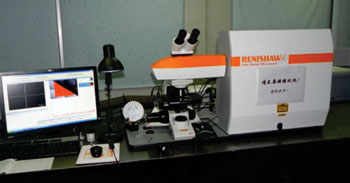Novel Method Developed for More Effective Noninvasive Prostate Cancer Screening
By LabMedica International staff writers
Posted on 17 Sep 2014
Comparing healthy volunteers and prostate cancer (PrCa) patients, researchers have successfully shown that their new method, which builds on the use of SERS spectroscopy of silver nanoparticles mixed with blood samples, could reveal cases of cancer.Posted on 17 Sep 2014
A team of researchers led by Prof. Shaoxin Li, of Guangdong Medical College (Guangdong province, China), has demonstrated potential of a new noninvasive method to screen for PrCa based on combining of the existing technique of serum surface-enhanced Raman scattering (SERS) with the new sophisticated analysis technique called support vector machine (SVM). Applying the combined SERS-SVM system to blood samples collected from 68 healthy volunteers and 93 people clinically confirmed to have PrCa, their technique identified the PrCa cases with 98.1% accuracy.

Image: Researchers have demonstrated potential for a new, noninvasive method to screen for prostate cancer using a detection system that combines surface-enhanced Raman scattering (SERS) with support vector machine (SVM) techniques (Photo courtesy of Prof. S. Li and Guangdong Medical College).
If the technique proves safe and effective in clinical trials, it may become an effective method available to patients and their doctors for improving early diagnosis of PrCa. “The results demonstrate that label-free serum SERS analysis combined with SVM diagnostic algorithm has great potential,” said Prof. Li, “Compared to traditional screening methods, this method has the advantages of being noninvasive, highly sensitive, and very simple.”
The blood test for elevated levels of PSA (prostate specific antigen) commonly used for PrCa screening and monitoring is far from perfect as elevated PSA levels can be caused by many factors unrelated to cancer. This contributes to over-diagnosis, uncomfortable tissue biopsies, and other unnecessary treatment, which can be costly and carry significant side-effects. Because of this, the US Preventative Services Task Force now recommends against PSA-based screening for PrCa.
Other scientists have considered applying SERS to cancer detection as it would seem to enable detection of the subtle marker signals. The challenge, said Prof. Li, was that the signal differences between the serum samples taken from the healthy volunteers and the PrCa patients were too subtle to detect. So his team employed also the powerful spectral data processing algorithm SVM – and found it to be effective. While the work is preliminary, it demonstrates that the method has good potential for PrCa screening. The next research step, added Prof. Li, is to refine the method and explore whether it can distinguish cancer staging.
The method, described by S. Li et al, was published in the journal Applied Physical Letters, September 2, 2014, online.
Related Links:
Guangdong Medical College














